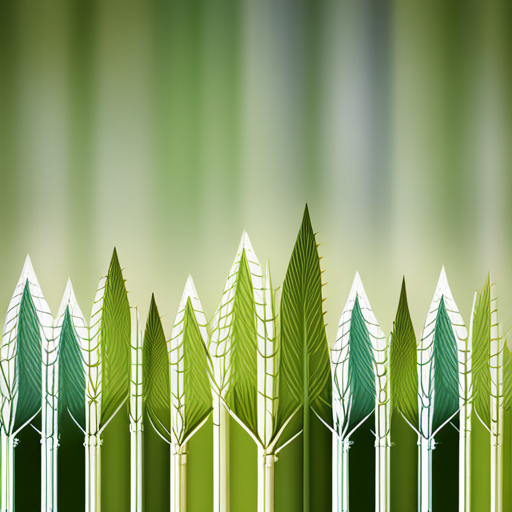Contents
- 1 Cold Hardy Bamboo Varieties For Zone 6 Gardens
- 1.1 Our Highlighted Points
- 1.2 Cold Hardy Bamboo
- 1.3 Growing Conditions and Preferences
- 1.4 Planting and Care Tips
- 1.5 Frequently Asked Questions
- 1.5.1 How can I prevent bamboo from spreading and becoming invasive in my garden?
- 1.5.2 Are there any specific diseases or pests that commonly affect bamboo in Zone 6?
- 1.5.3 Can bamboo be grown in containers in Zone 6?
- 1.5.4 How long does it take for bamboo to reach maturity and start producing shoots?
- 1.5.5 Are there any specific pruning techniques I should know for maintaining bamboo in Zone 6 gardens?
Cold Hardy Bamboo Varieties For Zone 6 Gardens
Bamboo is a versatile and popular plant that can thrive in a wide range of climates, including USDA Zone 6. In this article, we will explore the various cold hardy bamboo varieties that are suitable for Zone 6 gardens. With over a thousand species to choose from, there are options available to suit every gardener’s preferences.
Two of the most cold hardy groups of bamboo for Zone 6 are Phyllostachys and Fargesia. Phyllostachys are runners, while Fargesia are non-invasive clumping bamboos, making them particularly favorable for homeowners.
We will discuss some of the clumping non-invasive bamboo options, such as Fargesia robusta ‘Wolong’ and Fargesia dracocephala ‘Rufa’, as well as running bamboo options like Phyllostachys Aurea and Phyllostachys bissetii.
Additionally, we will provide valuable insights into the growing conditions and preferences of these bamboo varieties, including proper spacing, soil amendments, light requirements, and fertilization.
Furthermore, we will offer essential planting and care tips to ensure successful growth and establishment of bamboo in Zone 6 gardens.
Our Highlighted Points
- There are over a thousand species of bamboo suitable for growing in USDA Zone 6.
- Phyllostachys and Fargesia are the most cold hardy groups of bamboo.
- Fargesia is a popular choice for homeowners due to its non-invasive nature.
– Proper spacing, soil amendment, and watering are important for successful bamboo growth in Zone 6 gardens.
Cold Hardy Bamboo

Cold hardy bamboo varieties suitable for USDA Zone 6, such as Phyllostachys and Fargesia, are popular options for homeowners due to their non-invasive nature and ability to withstand cold temperatures.
With over a thousand species of bamboo available, it is important to choose the correct species that can thrive in this specific climate.
Phyllostachys, known as running bamboo, and Fargesia, known as non-invasive clumping bamboo, are the most cold hardy groups of bamboo.
Phyllostachys species are runners, which means they spread quickly and can become invasive if not properly controlled.
On the other hand, Fargesia species are non-invasive and form clumps, making them more suitable for homeowners who want to avoid the spread of bamboo in their landscape.
It is crucial to consider the climate requirements of different bamboo species before planting, as each variety has its own preferences for sunlight, soil conditions, and water requirements.
Growing Conditions and Preferences

In order to successfully cultivate bamboo in USDA Zone 6, it is essential to understand the specific growing conditions and preferences of different bamboo species.
Bamboo types have varying preferences when it comes to soil conditions. While bamboo can grow in various soil types, amending the soil with composted manure can improve growth.
Additionally, different bamboo varieties have different light requirements. Some bamboo varieties thrive in full sun, while others prefer partial shade. It is important to consider these light requirements when selecting bamboo for your Zone 6 garden.
By understanding the soil conditions and light preferences of different bamboo types, gardeners in Zone 6 can ensure the successful cultivation of this versatile and beautiful plant.
Planting and Care Tips

To ensure successful establishment and growth, proper planting techniques and regular care are crucial when cultivating bamboo in USDA Zone 6. When planting bamboo, it is important to consider the spacing requirements of the chosen variety. Bamboo can spread vigorously, so it is recommended to plant clumping bamboos at least 3 to 5 feet apart, while running bamboos should be spaced 5 to 10 feet apart, depending on the desired outcome.
Watering frequency is another important aspect of bamboo care. Newly planted bamboo requires frequent and generous watering until established. The amount of water needed depends on the size of the bamboo plant, with larger plants requiring more water. It is recommended to provide deep watering, ensuring that the water reaches the roots.
To summarize the spacing requirements and watering frequency for bamboo in USDA Zone 6:
| Variety | Spacing Requirements | Watering Frequency |
|---|---|---|
| Clumping | 3 to 5 feet apart | Frequent and generous |
| Running | 5 to 10 feet apart | Frequent and generous |
By following these guidelines, gardeners can ensure the successful growth and health of their bamboo plants in Zone 6.
You may also like to read about choosing hardy bamboo for Zone 5.
Frequently Asked Questions
How can I prevent bamboo from spreading and becoming invasive in my garden?
Bamboo containment methods include installing a root barrier, regularly pruning rhizomes, and using physical barriers. Best practices for controlling bamboo growth involve monitoring and removing any new shoots, as well as considering clumping varieties for a non-invasive option.
Are there any specific diseases or pests that commonly affect bamboo in Zone 6?
Common diseases and pests that commonly affect bamboo in zone 6 include bamboo mites, bamboo aphids, bamboo mealybugs, and bamboo scale insects. Effective treatments include insecticides, pruning affected areas, and promoting overall plant health through proper watering and fertilization.
Can bamboo be grown in containers in Zone 6?
Bamboo can be successfully grown in containers in Zone 6, allowing for the cultivation of this versatile plant indoors. Container gardening offers benefits such as control over growing conditions, mobility, and the ability to prevent invasive spread.
How long does it take for bamboo to reach maturity and start producing shoots?
The time it takes for bamboo to reach maturity and start producing shoots can vary depending on the species and growing conditions. Bamboo cultivation requires patience as the growth rate is slow in the first year but increases exponentially until maturity.
Are there any specific pruning techniques I should know for maintaining bamboo in Zone 6 gardens?
Pruning techniques for maintaining bamboo in Zone 6 gardens include removing dead or damaged canes, thinning out overcrowded areas, and cutting back lateral shoots to control spread. Regular pruning promotes healthy growth and prevents invasive tendencies.

